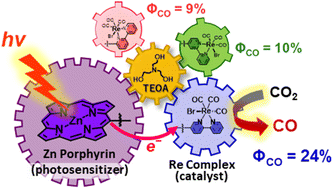Significance of the connecting position between Zn(ii) porphyrin and Re(i) bipyridine tricarbonyl complex units in dyads for room-temperature phosphorescence and photocatalytic CO2 reduction: unexpected enhancement by triethanolamine in catalytic activity†
Abstract
We synthesized three new dyads composed of a Zn porphyrin and fac-Re(bpy)(CO)3Br (bpy = 2,2′-bipyridine) units, ZnP-nBpy![[double bond, length as m-dash]](https://www.rsc.org/images/entities/char_e001.gif) ReBr (n = 4, 5, and 6), in which the porphyrin is directly connected at the meso-position through the 4-, 5-, or 6-position of the bpy. We investigated the relationships between the connecting positions and the photophysical properties as well as catalytic activity in the CO2 reduction reaction. The dyad connected through the 6-position, ZnP-6Bpy
ReBr (n = 4, 5, and 6), in which the porphyrin is directly connected at the meso-position through the 4-, 5-, or 6-position of the bpy. We investigated the relationships between the connecting positions and the photophysical properties as well as catalytic activity in the CO2 reduction reaction. The dyad connected through the 6-position, ZnP-6Bpy![[double bond, length as m-dash]](https://www.rsc.org/images/entities/char_e001.gif) ReBr, showed obvious phosphorescence with a lifetime of 280 μs at room temperature, in N,N-dimethylacetamide (DMA), whereas the other two dyads showed almost no phosphorescence under the same conditions. The photocatalytic CO2 reduction reactions in DMA using 1,3-dimethyl-2-phenyl-2,3-dihydro-1H-benzo[d]imidazole as the electron donor and the three dyads ZnP-nBpy
ReBr, showed obvious phosphorescence with a lifetime of 280 μs at room temperature, in N,N-dimethylacetamide (DMA), whereas the other two dyads showed almost no phosphorescence under the same conditions. The photocatalytic CO2 reduction reactions in DMA using 1,3-dimethyl-2-phenyl-2,3-dihydro-1H-benzo[d]imidazole as the electron donor and the three dyads ZnP-nBpy![[double bond, length as m-dash]](https://www.rsc.org/images/entities/char_e001.gif) ReBr selectively produced CO with similar initial rates, but the durabilities were low. The addition of triethanolamine (TEOA) suppressed the decomposition of dyads, improving their durabilities and reaction efficiencies. In particular, ZnP-5Bpy
ReBr selectively produced CO with similar initial rates, but the durabilities were low. The addition of triethanolamine (TEOA) suppressed the decomposition of dyads, improving their durabilities and reaction efficiencies. In particular, ZnP-5Bpy![[double bond, length as m-dash]](https://www.rsc.org/images/entities/char_e001.gif) ReBr was remarkably improved—it gave the highest durability and reaction efficiency among the three dyads; the reaction quantum yield reached 24%. The reason for this significant activity is no accumulation of electrons on the Zn porphyrin in ZnP-5Bpy
ReBr was remarkably improved—it gave the highest durability and reaction efficiency among the three dyads; the reaction quantum yield reached 24%. The reason for this significant activity is no accumulation of electrons on the Zn porphyrin in ZnP-5Bpy![[double bond, length as m-dash]](https://www.rsc.org/images/entities/char_e001.gif) ReBr, which would be caused by dual interactions of TEOA with the Re and Zn ions in the dyad. As the highest catalytic activity was observed in ZnP-5Bpy
ReBr, which would be caused by dual interactions of TEOA with the Re and Zn ions in the dyad. As the highest catalytic activity was observed in ZnP-5Bpy![[double bond, length as m-dash]](https://www.rsc.org/images/entities/char_e001.gif) ReBr among the three dyads, which had no room-temperature phosphorescence (RTP), the catalytic activities and RTP properties are considered independent, but they are greatly influenced by the connecting positions on the bpy ligand in ZnP-nBpy
ReBr among the three dyads, which had no room-temperature phosphorescence (RTP), the catalytic activities and RTP properties are considered independent, but they are greatly influenced by the connecting positions on the bpy ligand in ZnP-nBpy![[double bond, length as m-dash]](https://www.rsc.org/images/entities/char_e001.gif) ReBr.
ReBr.

- This article is part of the themed collections: 2023 Chemical Science HOT Article Collection and 2023 Chemical Science Covers


 Please wait while we load your content...
Please wait while we load your content...